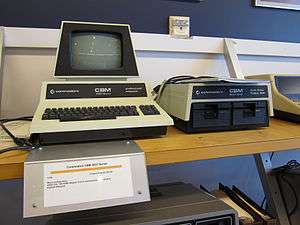Commodore 8050
|
Commodore 8050 floppy-disk drive, with CBM 2001 PC | |
| Manufacturer | Commodore Business Machines, Inc. |
|---|---|
| Type | Floppy drive |
| Release date | 8050: 1980[1][2] |
| Introductory price | 8050: USD 1695 (1980) USD 4,900 (2016 equivalent)[2] |
| Media |
2x 5¼" floppy disk 8050: SS DD 8250: DS DD |
| Operating system | CBM DOS 2.5/2.7[3] |
| CPU | 2x MOS 6502 @ 1 MHz[4] |
| Memory | 4 kB RAM 16 kB ROM[4] |
| Storage |
8050: 521 kB/drive 8250: 1042 kB/drive[3][2][5] |
| Connectivity | Parallel IEEE-488[6] 1.8 kB/s[3] |
| Power | 120 V 60 Hz 1 A fuse (8050 50 W ; 8250 60 W)[4] |
| Backward compatibility | PET, 4000-series, 8000-series, B128,[4] Commodore 64, VIC-20[3] |
The Commodore 8050 and Commodore 8250 are dual-unit 5¼" floppy disk drives for Commodore International computers. They use a wide rectangular steel case form similar to that of the Commodore 4040, and use the IEEE-488 interface common to Commodore PET/CBM computers.
The 8050 is a single-sided drive, whereas the 8250 can use both sides of a disk simultaneously. Both use a quad density format storing approximately 0.5 megabyte per side. The density of media is similar to later PC high density floppy disks, but with the original 300-oersted coercivity used by double density drives. The 8050 and 8250 did not write with enough power to use 600-oersted PC high density disks reliably. As quad-density disks were rare even at the time that these were current models, users quickly found that typical double density floppy disks had enough magnetic media density to work in these drives.
These drives are not dual-mode, so they cannot read or write disks formatted by the more common lower-capacity Commodore 1541 or Commodore 4040 models.
Some variants of these drives exist. The Commodore 8250LP is the 8250 in a lower profile, tan-colored case.[7][8] The Commodore SFD-1001 is a single-drive version of the 8250 in a Commodore 1541-style case[2] (similarly to the Commodore 2031LP), often used by bulletin board systems for their physical similarity to 1541s and high capacity and speed.
Disk Layout
| Track | Sectors Per Track (256 bytes) | Sectors |
|---|---|---|
| 1-39, 78-116 | 29 | 1131 |
| 40-53, 117-130 | 27 | 378 |
| 54-64, 131-141 | 25 | 275 |
| 65-77, 142-154 | 23 | 299 |
Total Sectors: 2083 (4166 for the 8250)
The disk header is on 39/0 (track 39, sector 0), with the directory residing on the remaining 28 sectors of track 39.
Header Layout 39/0
$00–01 T/S reference to the first BAM (block availability map) sector
02 DOS version ('C')
06-16 Disk label, $A0 padded
18-19 Disk ID
1B-1C DOS type('2C')
The BAM (block availability map) begins on 38/0 (track 38, sector 0), and continues on 38/3. On the 8250, the BAM extends further to 38/6 and 38/9. The remaining sectors on track 38 are available for general use.
BAM Layout 38/0, 3, (6, 9)
$00–01 T/S reference to the next BAM sector, or 00/FF if last.
02 DOS version ('C')
04 Lowest BAM track in this block
05 Highest+1 BAM track in this block
06-FF BAM for 50 tracks
See also
References
- Commodore 8050 Brochure
- optusnet.com.au/../SFD1001.htm TOOLS specifically for the SFD1001 & 8250 Drives.
- Commodore Knowledge Base
- Technical comparison of Commodore floppy drives (with drive capacities)
- Commodore Dual Disk Drives
- Daves Old Computers - Commodore PET (floppy drive images and info)
- ↑ "Commodore PET 4032 computer". 2013-12-10. Retrieved 2016-04-02.
1980: May - Commodore Business Machines introduces the CBM 8050 dual 5 1/4-inch floppy disk drive unit.
- 1 2 3 4 "The Personal Computer Museum, Brantford, Ontario, CANADA - Recycle, donate, and browse your old computers, electronics, video games, and software". Retrieved 2016-04-02.
- 1 2 3 4 "Manuals | Technical Comparison of Commodore 1541 2040 4040 8050 8250 Drives". 2011-03-30. Retrieved 2016-04-02.
DOS version(s) 2.6 2.6 2.1/2.7 2.5/2.7 2.7
- 1 2 3 4 "Service manual 8050 * 8250 Dual disk drives June 1985 PN-314011-03" (PDF). Commodore Business Machines, Inc. 1200 Wilson Drive, West Chester, Pennsylvania 19380 U.S.A. (published 2015-04-16). 1985. Retrieved 2016-04-02.
- ↑ "Commodore compatible Disk Drives". 1996-06-12. Retrieved 2016-04-30.
- ↑ "d8050b.jpg". 2004-09-10. Retrieved 2016-04-02.
- ↑ "Commodore 8250 LP Dual Disk Drive". 2010. Retrieved 2016-04-02.
- ↑ "Restoration & Repair A Commodore Dual Disk 8250 LP". 2013-12-17. Retrieved 2016-04-02.
